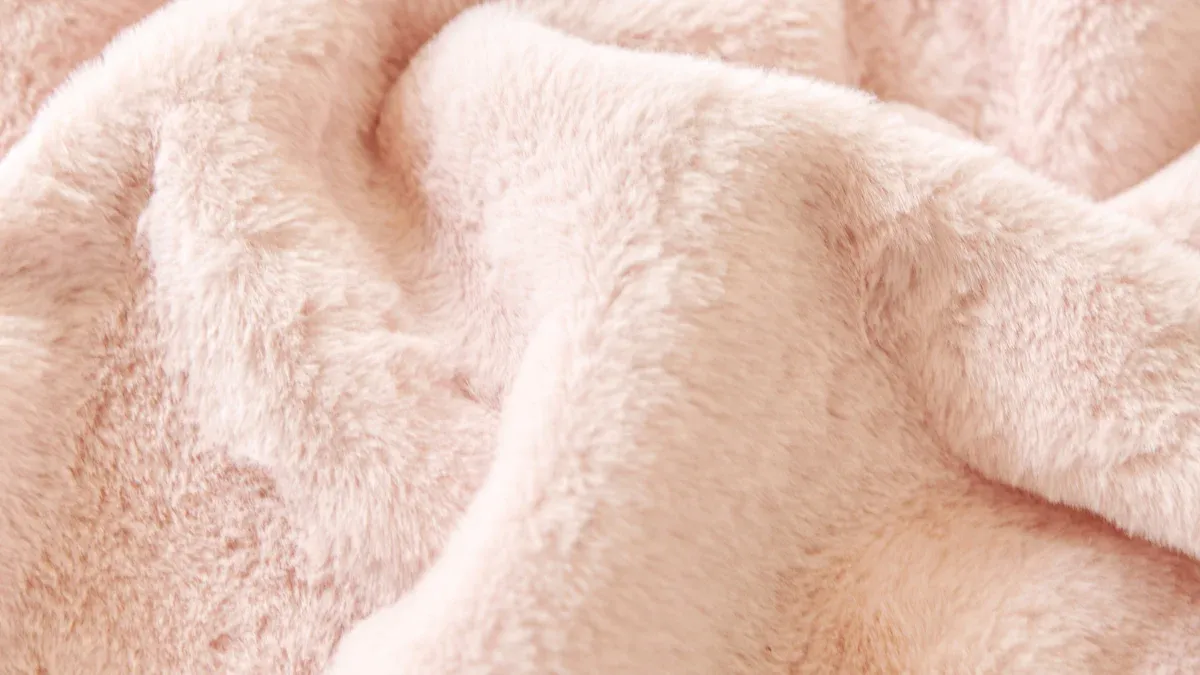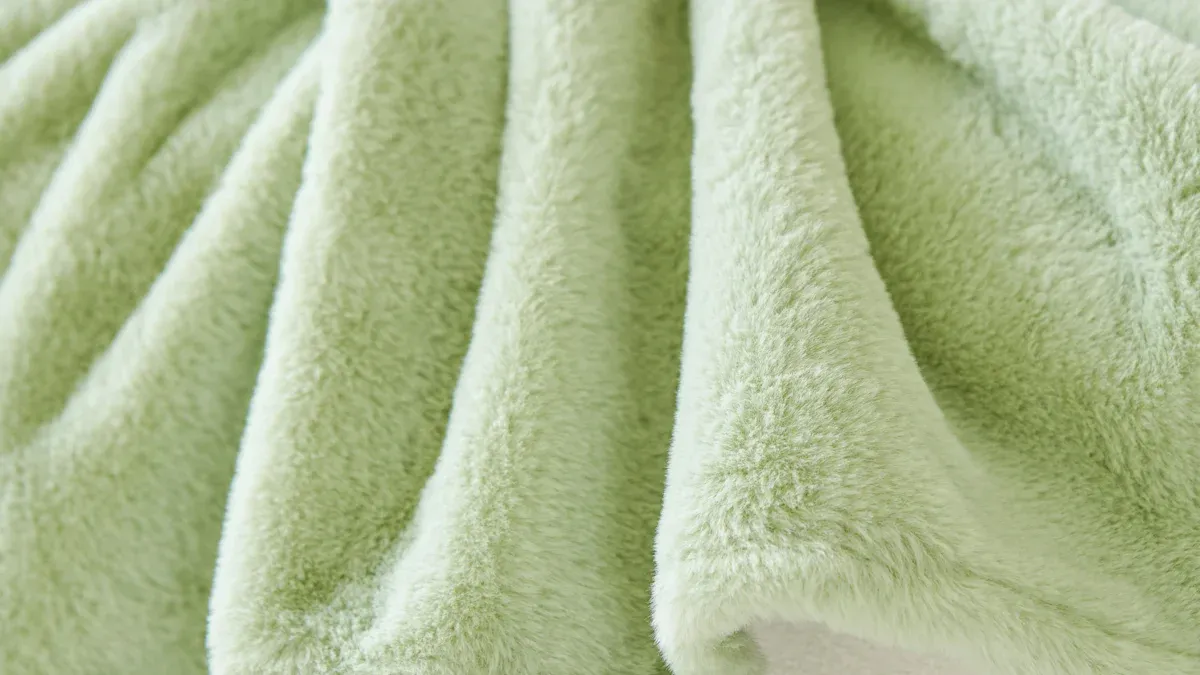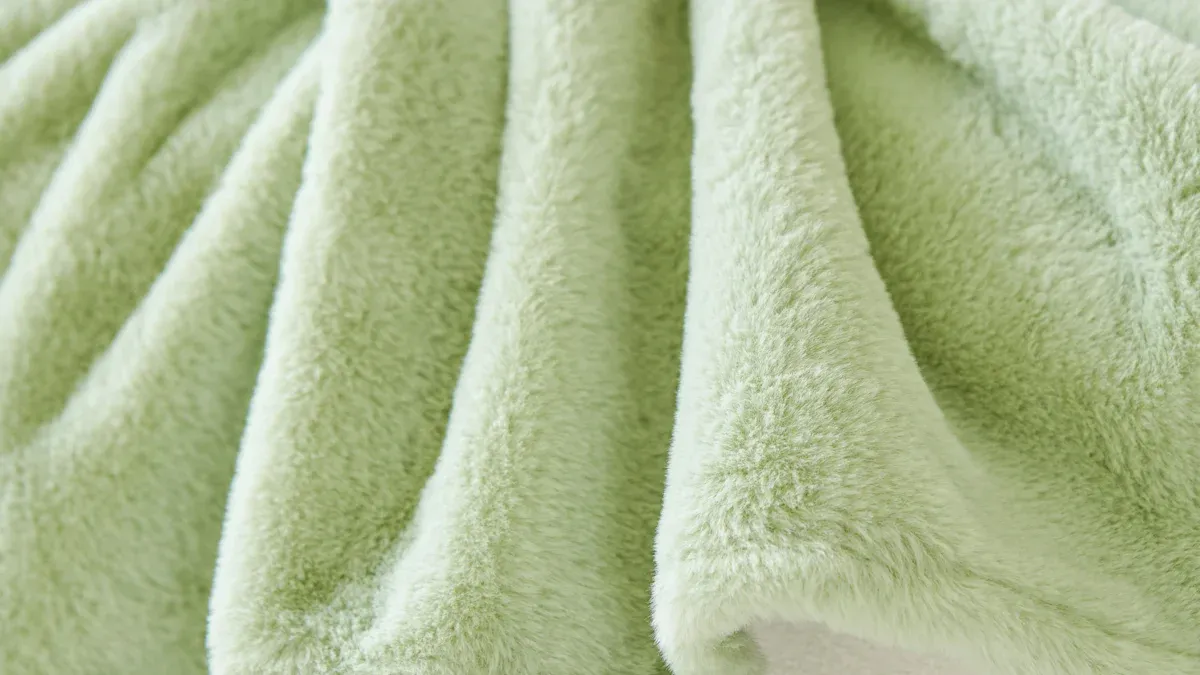
Fleece fabric combines practicality with comfort, making it a staple in apparel and home goods. Its economic significance is evident, with the market projected to grow to $736 million by 2025. This lightweight material, predominantly made from polyester blends, excels in providing warmth without bulk, meeting both affordability and functionality demands.
Key Takeaways
- Fleece fabric is light and keeps you warm. It’s great for winter clothes and home items.
- It dries fast and pulls sweat away, keeping you comfy and dry during outdoor fun.
- Fleece lasts long and is simple to clean. It stays soft even after many washes.
What Is Fleece Fabric?

Definition and General Characteristics
Fleece fabric is a synthetic textile known for its soft texture, lightweight feel, and excellent insulation properties. It is primarily made from polyester fibers, often blended with other materials like cotton or viscose to enhance its performance. The fabric’s structure is unique, featuring a face yarn, binding yarn, and a fleecy backing yarn. This design ensures a smooth outer surface while maintaining a plush, cozy interior.
A key characteristic of fleece fabric is its hydrophobic nature, which allows it to repel moisture and retain less than 1% of its weight in water. This property, combined with its breathability, makes it an ideal choice for outdoor and activewear. Additionally, fleece fabric offers durability and comfort, withstanding years of use without significant wear.
| Aspect | Details |
|---|---|
| Material Composition | Includes polyester, recycled polyester, and blends. |
| Performance Characteristics | Features such as water resistance, breathability, and wicking capabilities. |
| Innovations | Development of recycled fleece and enhanced performance fabrics. |
| Applications | Used in clothing (apparel linings, outerwear) and home textiles. |
| Market Trends | Focus on sustainability and technological advancements for improved functionality. |
How Fleece Is Made
The production of fleece fabric involves several steps, each contributing to its unique properties. Manufacturers begin by preparing the base cloth, selecting high-strength polyester fibers, and forming the fabric through knitting or weaving. A TPU coating or calendering process is then applied to enhance waterproof and windproof characteristics.
The next step, compounding processing, ensures a strong bond between the TPU layer and the base cloth. Finally, post-organization treatments, such as shaping, dyeing, and functional finishing, optimize the fabric’s performance. These processes result in a textile that is not only warm and durable but also versatile enough for various applications.
| Step | Description |
|---|---|
| 1 | Base cloth preparation involves selecting high-strength polyester fibers and using knitting or weaving processes to form fleece fabrics. |
| 2 | TPU coating/calendering applies a TPU film to provide waterproof and windproof characteristics. |
| 3 | Compounding processing ensures a strong bond between the TPU layer and the base cloth. |
| 4 | Post-organization includes shaping, dyeing, and functional finishing treatments. |
Common Uses of Fleece Fabric
Fleece fabric is widely used in both apparel and home goods due to its versatility and performance. In the apparel industry, it is a popular choice for hoodies, sweatshirts, and jackets, offering warmth and comfort for outdoor activities and casual wear. Brands like Patagonia and Uniqlo have embraced anti-pilling fleece for their products, catering to consumers who prioritize durability and quality.
In home textiles, fleece fabric is commonly found in blankets, throws, and bedding. Its softness and ability to retain warmth make it a favorite for cozy home environments. The demand for fleece fabric continues to grow, driven by its practicality and aesthetic appeal.
| Category | Common Uses |
|---|---|
| Hoodies | Ideal for outdoor activities, casual wear, and sports due to insulation. |
| Sweatshirts | Favored for cozy loungewear and activewear during cooler seasons. |
| Cardigans | Versatile layering pieces for changing temperatures. |
| Pants and Joggers | Comfortable for lounging and outdoor activities, retaining warmth. |
Types of Fleece Fabric
Microfleece
Microfleece is a lightweight and ultra-soft variation of fleece fabric, often favored for its thin profile and excellent insulation. It is commonly used in layering pieces such as base layers and lightweight jackets. Its fine fibers create a smooth texture, making it ideal for sensitive skin.
| Characteristic | Fiber Type 1 (Basic Yarn) | Fiber Type 2 (Loop Yarn) |
|---|---|---|
| Diameter | 8.82 ± 1.42 μm | 18.96 ± 1.62 μm |
| Flexibility | High | High |
| Dimensional Stability | High | High |
| Resistance to Rubbing and Creasing | High | High |
| Fabric Structure | Soft pile structure | Filling layer |
Microfleece excels in flexibility and dimensional stability, making it a durable choice for activewear. Its soft pile structure enhances comfort while maintaining resistance to creasing and wear.
Polar Fleece
Polar fleece is a thicker and warmer option, designed for cold-weather applications. It is widely used in jackets, blankets, and outdoor gear due to its superior insulation properties.
- Polartec Alpha and Polartec Fleece, both made from polyester, are popular knit insulations.
- Polar fleece offers low thermal resistance, making it suitable for high-exertion activities.
- Its insulation value is less than half that of other non-woven insulations, ensuring lightweight warmth.
Polar fleece balances warmth and breathability, making it a versatile choice for outdoor enthusiasts.
Sherpa Fleece
Sherpa fleece mimics the texture of wool, offering a plush and cozy feel. It is often used in linings for jackets, vests, and blankets. The fabric’s soft, fluffy surface provides excellent insulation, making it ideal for winter wear.
Sherpa fleece stands out for its aesthetic appeal and ability to retain warmth, making it a popular choice for both functional and decorative applications.
Cotton Fleece
Cotton fleece combines the natural properties of cotton with the comfort of fleece. It is breathable, hypoallergenic, and moisture-absorbent, making it suitable for sensitive skin.
- Cotton allows air circulation, preventing heat and moisture buildup.
- Its moisture-wicking capabilities enhance thermophysiological comfort.
- The softness of cotton fleece makes it ideal for loungewear and casual apparel.
Natural fibers like cotton excel in breathability and comfort, ensuring a pleasant wearing experience.
Polyester Fleece
Polyester fleece is a synthetic option known for its durability and moisture-wicking properties. It is widely used in activewear and outdoor gear due to its quick-drying capabilities.
- Polyester absorbs less than 3% of moisture, ensuring dryness during high-intensity activities.
- Its tensile strength exceeds 5 grams per denier, highlighting its durability.
- Drying times of 30 minutes or less make it ideal for workouts and outdoor adventures.
Polyester fleece offers long-lasting performance and practicality, making it a reliable choice for demanding environments.
Benefits of Fleece Fabric

Warmth and Insulation
Fleece fabric excels in providing warmth and insulation, making it a preferred choice for cold-weather apparel and home goods. Its hydrophobic nature ensures minimal moisture absorption, allowing it to retain heat even in damp conditions. Microfleece, in particular, is celebrated for its thermal efficiency, offering comfort during colder months.
- Technological innovations have enhanced the insulation features of fleece blankets, catering to consumer demands for warmth.
- Smart technology integration, such as temperature regulation systems, is reshaping expectations for comfort.
- Eco-friendly materials, including recycled polyester, are gaining popularity, addressing sustainability concerns.
The ability of fleece fabric to balance warmth and breathability makes it ideal for outdoor gear and casual wear. Its lightweight structure ensures effective insulation without adding bulk, making it suitable for layering during winter activities.
Lightweight and Comfortable
Fleece fabric combines a lightweight feel with exceptional comfort, making it a versatile material for clothing and home textiles. Its soft texture and plush interior provide a cozy experience, whether used in jackets, hoodies, or blankets.
The fabric’s lightweight nature allows for easy movement, making it a favorite for activewear. Microfleece, with its fine fibers, offers a smooth texture that is gentle on sensitive skin. This combination of comfort and practicality ensures that fleece fabric remains a staple in everyday apparel.
Tip: When selecting fleece products, consider microfleece for layering pieces and polar fleece for added warmth during outdoor activities.
Durable and Long-Lasting
Fleece fabric is renowned for its durability, withstanding years of use without significant wear. Its synthetic composition resists shrinking and stretching, ensuring long-term performance. Durability tests and consumer reviews validate its reliability across various applications.
| Product Name | Durability Features |
|---|---|
| Patagonia R2 Techface Hoody | Described as light but durable for outdoor activities. |
| Norrøna Powerstretch Pro Zip Hoody | Noted for being supersoft and durable, tested for long-term use. |
| Patagonia R1 Hoody | On the market for two decades, indicating long-term durability. |
Fleece fabric’s ability to maintain its structure and appearance over time makes it a cost-effective choice for consumers seeking quality and longevity.
Affordable and Accessible
Fleece fabric stands out for its affordability and accessibility, appealing to a wide range of consumers. It is often less expensive than high-end fabrics, making it a practical option for families, students, and budget-conscious buyers.
- Fleece products are widely available across various regions, enhancing their market presence.
- The affordability of fleece fabric increases its accessibility for diverse demographics.
The combination of cost-effectiveness and widespread availability has driven the popularity of fleece blankets and apparel. Consumers appreciate its ability to deliver comfort and functionality at an accessible price point.
Unique Properties of Fleece Fabric
Moisture-Wicking and Quick-Drying
Fleece fabric stands out for its moisture-wicking and quick-drying capabilities, making it a preferred choice for activewear and outdoor gear. Its synthetic fibers, such as polyester, feature a raised surface that effectively traps heat while shedding water. This construction ensures that moisture is drawn away from the skin, keeping the wearer dry and comfortable during physical activities.
Thermal imaging studies demonstrate how moisture spreads across fleece fabric over time, highlighting its efficiency in wicking. Vertical wicking tests further confirm its ability to transport water upward through fabric strips, while evaporative cooling is visualized as temperature drops in wet areas.
- Polypropylene and acrylic fibers enhance moisture-wicking performance.
- Cotton, by contrast, absorbs moisture, leading to discomfort during prolonged activity.
- Synthetic fabrics, including fleece, outperform cotton in wicking rates and drying times.
| Property | Result |
|---|---|
| Water Vapor Permeability | Significant differences observed |
| Drying Time | Evaluated |
| Bursting Strength | Compared across samples |
These properties make fleece fabric an excellent option for individuals seeking comfort and functionality in demanding environments.
Breathability
The breathability of fleece fabric ensures optimal comfort by allowing air to circulate freely. This property prevents overheating during physical exertion or in warmer conditions. Laboratory tests, such as air permeability evaluations, confirm the fabric’s ability to facilitate airflow. Moisture management testing further demonstrates its capacity to wick sweat away from the body, maintaining dryness and comfort.
Thermal resistance testing reveals that fleece fabric balances insulation with breathability, making it suitable for a wide range of environmental conditions. This unique combination of properties ensures that fleece fabric remains a reliable choice for both casual and performance wear.
Easy to Care For
Fleece fabric is remarkably easy to care for, making it a practical option for everyday use. Its synthetic composition resists shrinking and stretching, even after multiple washes. Laboratory analyses show minimal impact on the fabric’s structure after repeated laundering.
| Washing Cycle | Physical Appearance Impact | Microplastics Release Comparison |
|---|---|---|
| 1st Wash | Significant difference noted | Higher release during drying than washing |
| 10th Wash | Minimal impact on structure | Less microplastics released during washing than drying |
Fleece fabric dries quickly, reducing the time and energy required for maintenance. Its durability and low-maintenance nature make it a cost-effective and convenient choice for consumers.
How to Care for Fleece Fabric
Washing Tips
Proper washing techniques are essential to maintain the quality and longevity of fleece fabric. Machine washing in warm water with a mild detergent is recommended. This method effectively cleans the fabric without compromising its softness or structure. Fabric softeners should be avoided, as they can diminish the material’s moisture-wicking properties.
For optimal results, turn fleece garments inside out before washing. This reduces friction and prevents pilling. Use a gentle cycle and avoid overloading the washer to minimize mechanical agitation. Washing fleece items separately from abrasive materials, such as denim or towels, further protects the fabric from damage.
Tip: Tumble dry fleece on low heat or air dry to preserve its texture and softness.
Drying and Storage
Drying fleece fabric correctly ensures its durability and prevents shrinkage. Air drying is the preferred method. Lay the fabric flat on a towel, away from direct sunlight, to prevent color fading. If using a dryer, select a low-temperature setting and place the garment in a protective bag to reduce wear.
When storing fleece items, fold them carefully to maintain their shape and softness. Rolling the fabric is an excellent alternative for limited storage space, as it prevents stretching and preserves elasticity. Avoid hanging fleece garments for extended periods, as this can lead to distortion.
Avoiding Pilling and Damage
Pilling occurs when loose fibers form small balls on the fabric’s surface. To prevent this, turn fleece garments inside out before washing. Use cold water and a gentle cycle to minimize wear. Avoid overloading the washer, as excessive rubbing can accelerate pilling.
Wash fleece separately to prevent contact with abrasive items. A mild detergent is ideal for maintaining the fabric’s softness. Fabric softeners should be avoided, as they can strip natural oils and weaken the fibers. After washing, dry fleece flat to prevent stretching or damage. Regular brushing can also help maintain the fabric’s appearance by removing loose fibers.
Note: Following these care tips will extend the life of fleece fabric, ensuring it remains soft, durable, and comfortable.
Fleece fabric offers unmatched versatility and practicality for clothing and home goods. Its warmth, durability, and affordability make it a reliable choice for consumers. Selective breeding studies in cashmere goats and Paco-Vicunas demonstrate how genetic advancements enhance fleece quality, ensuring superior insulation and comfort. With proper care, fleece fabric delivers long-lasting value for everyday use.
FAQ
What makes fleece fabric suitable for outdoor activities?
Fleece fabric offers excellent insulation, moisture-wicking properties, and breathability. These features ensure comfort and warmth during outdoor activities, even in cold or damp conditions.
Can fleece fabric be used year-round?
Yes, fleece fabric works well in all seasons. Lightweight options like microfleece are ideal for layering in spring or fall, while polar fleece provides warmth during winter.
How does fleece fabric compare to wool?
Fleece fabric is lighter, more affordable, and easier to care for than wool. It also dries faster and resists moisture, making it a practical alternative for many applications.
Post time: Jun-09-2025